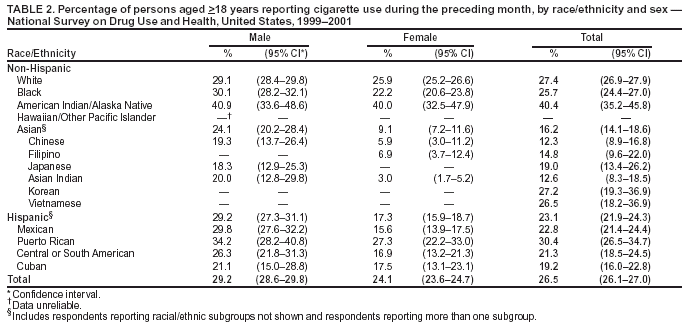Prevalence of Cigarette Use Among 14 Racial/Ethnic Populations --- United States, 1999--2001
Download PDF Version What is PDF?
Reported by: R Carmona, MD, Office of the Surgeon General. J Gfroerer, Office of Applied Studies, Substance Abuse and Mental Health Svcs Admin. R Caraballo, PhD, SL Yee, MPH, C Husten, MD, T Pechacek, PhD, RG Robinson, DrPH, Office on Smoking and Health, National Center for Chronic Disease Prevention and Health Promotion; C Lee, PhD, EIS Officer, CDC.
Source: Centers for Disease Control and Prevention, Prevalence of Cigarette Use Among 14 Racial/Ethnic Populations --- United States, 1999--2001, MMWR, 53(03);49-52, January 30, 2004
Public Domain
Table of Contents (TOC)
Article: Prevalence of Cigarette Use Among 14 Racial/Ethnic Populations --- United States, 1999--2001Editorial Note
Tables
References
The 1998 Surgeon General’s report, Tobacco Use Among U.S. Racial/Ethnic Minority Groups, addressed diverse tobacco-control needs of the four primary U.S. racial/ethnic minority populations: non-Hispanic blacks, American Indians/Alaska Natives (AI/ANs), Asians/Pacific Islanders, and Hispanics.1 However, data on these populations do not describe differences in tobacco-use prevalence among subsets of these populations. To assess the prevalence of cigarette smoking among persons aged >12 years among 14* racial/ethnic populations in the United States, CDC analyzed self-reported data collected during 1999--2001 from the National Survey on Drug Use and Health (NSDUH) (formerly the National Household Survey on Drug Abuse). This report summarizes the results of that analysis, which indicated that the prevalence of cigarette smoking among adults aged >18 years ranged from 40.4% for AI/ANs to 12.3% for the Chinese population, and the prevalence among youths aged 12--17 years ranged from 27.9% for AI/ANs to 5.2% for the Japanese population. Implementing tobacco-control programs that include culturally appropriate interventions can help reduce tobacco use among racial/ethnic populations.
 NSDUH is an annual household survey that collects information
on drug use and abuse from a nationally representative sample
of the U.S. civilian, noninstitutionalized population aged >12
years. The average, weighted, overall response rate for
the 1999--2001 surveys was 74.0% for youths and 64.8% for
adults; final sample sizes were 74,318 youths and 133,081
adults. Racial/ethnic classifications by NSDUH were based
on standards for collecting racial/ethnic data within the
federal statistical system.2 Prevalences and confidence
intervals (CIs) were calculated by using SUDAAN, and data
were weighted to account for different probabilities of
selection within strata.
NSDUH is an annual household survey that collects information
on drug use and abuse from a nationally representative sample
of the U.S. civilian, noninstitutionalized population aged >12
years. The average, weighted, overall response rate for
the 1999--2001 surveys was 74.0% for youths and 64.8% for
adults; final sample sizes were 74,318 youths and 133,081
adults. Racial/ethnic classifications by NSDUH were based
on standards for collecting racial/ethnic data within the
federal statistical system.2 Prevalences and confidence
intervals (CIs) were calculated by using SUDAAN, and data
were weighted to account for different probabilities of
selection within strata.
Current cigarette smoking was assessed by asking respondents, "During the past 30 days, have you smoked part or all of a cigarette?" Persons who answered "yes" were classified as current smokers. This definition for current smokers is different from that used by certain other surveys,1 which define adult current smokers as persons aged >18 years who have smoked >100 cigarettes during their lifetimes and who currently smoke every day or some days.
 Among youths, AI/ANs had the greatest cigarette smoking
prevalence (27.9%), followed by non-Hispanic whites (16.0%),
who had greater cigarette smoking prevalence than nine other
populations (non-Hispanic blacks, Chinese, Filipinos, Japanese,
Asian Indians, Vietnamese, Mexicans, Puerto Ricans, and
Central or South Americans) (Table 1).
Among non-Hispanic white youths, females had a greater prevalence
of cigarette smoking (17.2%) than males (14.9%). Among non-Hispanic
black youths, males had a greater prevalence of cigarette
smoking (8.2%) than females (5.9%).
Among youths, AI/ANs had the greatest cigarette smoking
prevalence (27.9%), followed by non-Hispanic whites (16.0%),
who had greater cigarette smoking prevalence than nine other
populations (non-Hispanic blacks, Chinese, Filipinos, Japanese,
Asian Indians, Vietnamese, Mexicans, Puerto Ricans, and
Central or South Americans) (Table 1).
Among non-Hispanic white youths, females had a greater prevalence
of cigarette smoking (17.2%) than males (14.9%). Among non-Hispanic
black youths, males had a greater prevalence of cigarette
smoking (8.2%) than females (5.9%).
Among adults, AI/ANs had the greatest cigarette smoking prevalence (40.4%) and the Chinese population had the lowest (12.3%) (Table 2). Prevalence among non-Hispanic blacks was similar (25.7%) to that among non-Hispanic whites (27.4%). Cigarette smoking prevalence among half of the adult racial/ethnic populations (Chinese, Filipino, Japanese, Asian Indian, Mexican, Central or South American, and Cuban) was less than among non-Hispanic whites. Among adults, smoking prevalence was greater among men in all racial/ethnic populations except AI/ANs, Puerto Ricans, and Cubans, which had no statistically significant variance by sex.
The findings in this report indicate that cigarette smoking varies among and within racial/ethnic populations, with AI/ANs having the highest prevalence of cigarette smoking among both youths and adults in the United States.1, 3, 4 Disparities in smoking prevalence might be attributable to various factors. Non-Hispanic black youths are less likely to regard smoking as part of their lifestyle and perceive strong parental and community disapproval of smoking.5 Strong parental disapproval also is observed among Hispanic populations, especially regarding smoking among females.1 However, no single factor determines the prevalence of cigarette smoking among racial/ethnic populations; current smoking prevalence is the result of complex interactions of multiple factors, including socioeconomic status, cultural characteristics, acculturation, stress, advertising, cigarette prices, parental and community disapproval, and abilities of local communities to mount effective tobacco-control initiatives.
 Among youths, smoking prevalence varied substantially by sex only among
non-Hispanic whites (i.e., females had a greater prevalence) and among
non-Hispanic blacks (i.e., males had a greater prevalence). Other national
youth surveys report no overall difference between males and females
in smoking prevalence.1, 6, 7
The similarity in prevalence among Asian and Hispanic youths might reflect
a loss of cultural constraints regarding smoking among females.
Among youths, smoking prevalence varied substantially by sex only among
non-Hispanic whites (i.e., females had a greater prevalence) and among
non-Hispanic blacks (i.e., males had a greater prevalence). Other national
youth surveys report no overall difference between males and females
in smoking prevalence.1, 6, 7
The similarity in prevalence among Asian and Hispanic youths might reflect
a loss of cultural constraints regarding smoking among females.
Among adults, men usually had a higher smoking prevalence than women from the same racial/ethnic population. The findings also indicate substantial variability in adult smoking rates among Asian and Hispanic populations. The lack of such variability among youths might have occurred because the prevalence estimates are less precise.
During 1965--2001, among adults, cigarette smoking declined more rapidly among non-Hispanic blacks than among non-Hispanic whites. As a result, the prevalence of smoking among non-Hispanic black adults is now similar to that of white adults, and current smoking among non-Hispanic black women is now less than that among non-Hispanic white women.8 Increased prevention and control initiatives targeted specifically at non-Hispanic blacks during the 1990s might explain part of this decline.9
The findings in this report are subject to at least three limitations. First, the precision of smoking prevalence estimates for certain populations is low, especially when reported by sex; differences in prevalence between males and females and among racial/ethnic populations might be missed, and estimates should be interpreted with caution. Second, no adjustments for multiple comparisons were performed to determine whether differences between any pair of estimates were statistically significant. Such differences might be significant even if CIs overlap. Finally, youths who did not want their parents to know they smoked might have denied smoking. This concern is relevant in NSDUH and other surveys conducted in the households of participants.3
 Although the prevalence of youth cigarette smoking among the majority
of racial/ethnic minority populations was less than that among
non-Hispanic whites, among adults, the prevalence in certain populations
(e.g., non-Hispanic blacks, Koreans, Vietnamese, and Puerto Ricans)
was similar to that of non-Hispanic whites.1 Multiple
factors might account for this similarity. Cessation rates among certain
racial/ethnic populations might be lower than those among non-Hispanic
whites. Racial/ethnic minority populations commonly have less
access than non-Hispanic whites to culturally and linguistically appropriate
anti-smoking educational materials, media messages, and cessation services.1 Moreover, racial/ethnic minority populations
have been targets of tobacco industry marketing efforts, including sponsorships
of cultural events and funding of organizations.1
Although the prevalence of youth cigarette smoking among the majority
of racial/ethnic minority populations was less than that among
non-Hispanic whites, among adults, the prevalence in certain populations
(e.g., non-Hispanic blacks, Koreans, Vietnamese, and Puerto Ricans)
was similar to that of non-Hispanic whites.1 Multiple
factors might account for this similarity. Cessation rates among certain
racial/ethnic populations might be lower than those among non-Hispanic
whites. Racial/ethnic minority populations commonly have less
access than non-Hispanic whites to culturally and linguistically appropriate
anti-smoking educational materials, media messages, and cessation services.1 Moreover, racial/ethnic minority populations
have been targets of tobacco industry marketing efforts, including sponsorships
of cultural events and funding of organizations.1
Interventions are needed to decrease current cigarette smoking among specific racial/ethnic populations with high smoking prevalence and to prevent increases in cigarette smoking among specific racial/ethnic populations with low smoking prevalence. Effective tobacco-control initiatives could result from 1) increasing the capacity (i.e., through increased funding for program development, training, evaluation, and research) of specific populations to address tobacco use within their communities; 2) conducting educational campaigns that are culturally competent and targeted to the specific needs and concerns of racial/ethnic populations;10 and 3) drawing on the strengths and assets of these racial/ethnic communities. Tobacco-control initiatives based on these practices can reduce disparities related to smoking prevalence, exposure to secondhand smoke, and the burden of smoking-related disease.


1. CDC. Tobacco use among U.S. racial/ethnic minority groups: a report of the Surgeon General. Atlanta, Georgia: U.S. Department of Health and Human Services, 1998.
2. Office of Management and Budget. Standards for the classification of federal data on race and ethnicity. Federal Register 1995;60 FR 4674--93.
3. CDC. Preventing tobacco use among young people: a report of the Surgeon General. Atlanta, Georgia: U.S. Department of Health and Human Services, 1994.
4. CDC. Surveillance for health behaviors of American Indians and Alaska Natives: findings from the Behavioral Risk Factor Surveillance System, 1997--2000. In: CDC Surveillance Summaries (August 1). MMWR 2003;52(No. SS-7).
5. Mermelstein R. Explanations of ethnic and gender differences in youth smoking: a multi-site qualitative investigation. Nicotine Tob Res 1999;1(suppl 1):S91--S98.
6. CDC. Trends in cigarette smoking among high school students---United States, 1991--2001. MMWR 2002;51:409--12.
7. CDC. Tobacco use among middle and high school students---United States, 2002. MMWR 2003;52:1096--8.
8. CDC. Cigarette smoking among adults---United States, 2001. MMWR 2003;52:953--6.
9. Robinson RG, Headen SW. Tobacco use and the African American community: a conceptual framework for the year 2000 and beyond. In: Forst ML, ed. Planning and Implementing Effective Tobacco Education and Prevention Programs. Springfield, Illinois: Charles C. Thomas, 1999.
10. Office of Minority Health. Closing the health gap. U.S. Department of Health and Human Services, Office of Minority Health, 2003. Available at http://www.healthgap.omhrc.gov.


